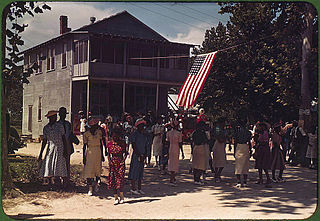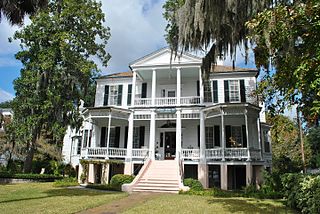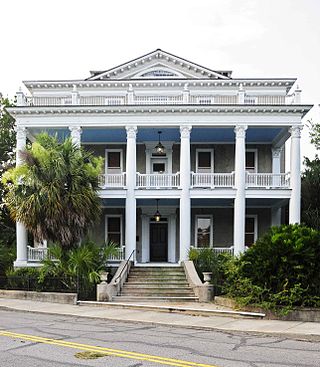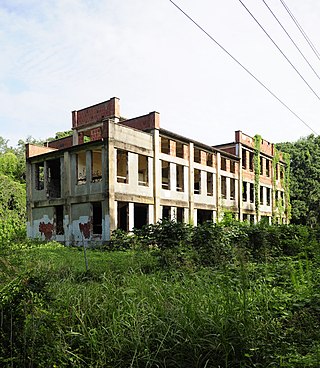
Beaufort is a city in and the county seat of Beaufort County, South Carolina, United States. Chartered in 1711, it is the second-oldest city in South Carolina, behind Charleston. Beaufort is known as the "Queen of the Carolina Sea Islands". The city's population was 13,607 at the 2020 census. It is part of the Hilton Head Island–Bluffton metropolitan area.

St. Helena Island is a Sea Island in Beaufort County, South Carolina, United States. The island is connected to Beaufort by U.S. Highway 21. The island has a land area of about 64 sq mi (170 km2) and a population of 8,763 as of the 2010 census. It is included as part of the Hilton Head Island-Beaufort Micropolitan Area. The island is renowned for its rural Lowcountry character and being a major center of African-American Gullah culture and language. It is considered to be the geographic influence behind the children's television program Gullah Gullah Island.
Fort Frederick Heritage Preserve is a 3-acre (12,000 m2) property located in Port Royal, South Carolina. Situated along the Beaufort River, the preserve contains the remains of Fort Frederick. Also known as Fort Prince Frederick, the tabby fort was built by the British between 1730 and 1734 to defend against a possible attack from the Spanish at St. Augustine, Florida. It was named to the National Register of Historic Places in 1974.

The Barnwell-Gough House, also known as Old Barnwell House, is a house built in Beaufort, South Carolina in 1789.

John A. Cuthbert House is a house built in 1811 in Beaufort. It was listed on the National Register of Historic Places in 1972.

The Anchorage, also known as William Elliott House, in Beaufort, South Carolina, is a house built in 1776. It was listed on the National Register of Historic Places in 1971.
The Charlesfort-Santa Elena Site is an important early colonial archaeological site on Parris Island, South Carolina, United States. It contains the archaeological remains of a French settlement called Charlesfort, settled in 1562 and abandoned the following year, and the later 16th-century Spanish settlement known as Santa Elena. The Spanish remains include a fort built directly on top of the abandoned Charlesfort remains.
Frogmore is an unincorporated community on St. Helena Island in Beaufort County, South Carolina, United States, along U.S. Route 21.

John Mark Verdier House, also known as Lafayette Building, is a building in Beaufort, South Carolina. It was built by John Mark Verdier, a French Huguenot, in 1804. The house typified Beaufort's gracious antebellum architectural style. It was a focal point of the town, a visible statement reflecting Verdier's significant wealth from trading indigo and growing sea island cotton.

This is a list of the National Register of Historic Places listings in Beaufort County, South Carolina.

Fort Fremont was a military installation on Saint Helena Island, Beaufort County, South Carolina. The fort and battery is historically significant as an example of late nineteenth and early twentieth century military architecture and as one of two surviving coastal fortifications in the United States intact from the Spanish–American War era.

The Camp Saxton Site is a 6-acre (24,000 m2) property located in Port Royal, South Carolina. It was listed in the National Register Historic Places on February 2, 1995.

The Seacoast Packing Company is a historic packing house in Beaufort, South Carolina that was listed on the National Register of Historic Places in 2008. Also known as Peninsular Canning Company/Pig Factory and as Pickle Factory, it was built by Brooks Engineering. It was listed on the National Register of Historic Places in 2008.
Altamaha Town is an archaeological site in the Bluffton, South Carolina area. It was the location of Altamaha, the head town of the Lower Towns of the Yamasee tribe during their entire 30 year presence in South Carolina. Evidence dates the beginning of this period from 1707–1715, though it is possible the town was formed as early as 1695. The area encompassed over 100 acres (40 ha) and 40 houses. There is also archaeological evidence to suggest that the site was also occupied intermittently prior to the arrival of the Yamasee, from at least 1500 BC to 1715 AD.
Chester Field, located in Beaufort County, South Carolina, is one of the nearly two dozen prehistoric shell rings that run from the center coast of South Carolina to the central coast of Georgia. Archaeologists date the pottery that has been found at these sites to be in the second millennium BC, this placing the artifacts among the earliest pottery of North America. The purpose or use of the ring shape is not known. This “address restricted” site was listed in the National Register of Historic Places on October 15, 1970.

The Coffin Point Plantation Caretaker's House, located in the Frogmore area of Beaufort County, South Carolina and in the shadows of the nearby Coffin Point Plantation, was built in 1892 as a residence for the plantation's caretaker. The Queen Anne style of architecture is considered marginally interesting, but it is noteworthy in that it is the only home known at this time that employed this style. During this era in the plantation's history, the site primary dwelling was owned by James Donald Cameron, who was the Secretary of War under Ulysses S. Grant, and later, United States Senator from 1877 to 1897. The Coffin Point Plantation Caretaker's House was listed in the National Register of Historic Places on May 26, 1989.
The Fort Lyttelton Site, located in Beaufort County, South Carolina, is significant for its rich and layered artifacts and structural remains., These provide a composite view of land use since colonial times. In the 18th century and early into the 19th century, the land was primarily used for military purposes. In the late 19th century, the "phosphate period" followed the military period. Shipbuilding became important in the early 20th century. The Fort Lyttelton Site was listed in the National Register of Historic Places on September 13, 1979.
Hasell Point, an “address restricted” landmark in Beaufort County, South Carolina, with its mix of burial mounds, potter and an oyster shell midden, is a potentially important archaeological site, one that may yield significant information dating to 500 AD. Hasell Point was listed in the National Register of Historic Places on August 14, 1973.
Orange Grove Plantation is a historic plantation house and national historic district located on Saint Helena Island near Frogmore, Beaufort County, South Carolina. The district encompasses one contributing building and two contributing sites, and reflects the early-20th century influx of Northerners onto St. Helena Island. The plantation was first recorded in 1753 when Peter Perry purchased 473 acres. Perry owned 46 chattel slaves. The plantation house, built about 1800, was in poor condition when Henry L. Bowles (1866-1932), a U.S. Representative from Massachusetts, bought the property in 1928. He demolished it and built the present house in the same year. The property also includes the tabby ruin of the kitchen, built about 1800, and a tabby-walled cemetery containing three early-19th century graves of the Fripp and Perry families.
Fort Mitchel is an American Civil War fortification at 65 Skull Creek Drive in Hilton Head, South Carolina.















